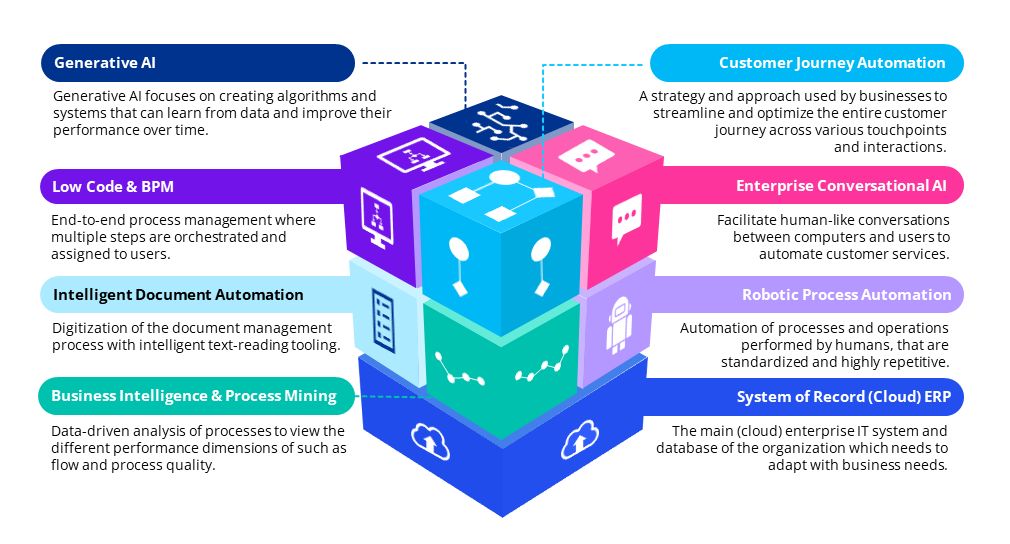Picture this: Immediately after a car accident, you report a claim to your insurance company. Within a minute, you receive a notification that your car will be evaluated for claim processing. Ten minutes later, the claim is approved and the payout process initiated. Unbelievably quick, right? You might find yourself riddled with curiosity about the mechanism behind this swift response.
The answer lies in the use of hyperautomation – a concept introduced by Gartner with the goal to automate every aspect within an organization that can possibly be automated. Look upon hyperautomation as your own digital workforce, a highly efficient and tireless team working behind the scenes. It employs advanced technologies like Artificial Intelligence (AI) and Robotic Process Automation (RPA) to swiftly process tasks that would normally require human intervention.
In the scenario of the car insurance claim, hyperautomation tools could instantly gather necessary data from your claim report (like the extent of damage and your coverage details), quickly assess the validity of the claim, and automatically initiate the payout process upon approval, all within minutes. While traditional automation is focused on accomplishing repetitive tasks without human intervention, hyperautomation advances further. It orchestrates end-to-end process automation throughout the organization, creating an adaptable and responsive ecosystem. Its strength lies in seamlessly interlinking various automation tools, improving speed, and precision in task transitions. So, the rapid claim approval and payment you experienced was not magic, but the power of hyperautomation at work!
Hyperautomation, unlocks a multitude of benefits for businesses:
- Enhanced Customer and Employee Experience: In customer-facing functions, hyperautomation enables 24/7 customer service with personalized interactions and quick response times, enhancing the customer experience and improving loyalty and retention. Additionally, the automation of routine tasks allows employees to save time and energy, enabling them to concentrate on value-added activities and the development of innovative ideas.
- Increased Efficiency: Automation across different business functions, such as procurement and customer service, leads to significant time and resource efficiency. As the number of automated tasks increases and the need for manual intervention decreases, room is created for focusing on value-added tasks and innovation, potentially leading to even further cost savings.
- Speed and Flexibility: Hyperautomation can reduce process times from days to minutes, helping the organization to respond more quickly to customer needs and market changes. Additionally, it offers the flexibility to modify processes as and when needed, supporting an agile business model.
- Improved Decision-Making: Hyperautomation does not just automate processes; it also automates the extraction of insights from data. This supports faster, more informed decision-making, helping businesses to capitalize on opportunities and mitigate risks more effectively.
Each of these benefits links directly to key organizational objectives – whether that is driving growth, improving customer satisfaction, or enhancing productivity – making hyperautomation a strategic imperative in the digital age.
Leverage the potential of Hyperautomation with your digital stack
Hyperautomation bridges the gap between the system of record, your core systems, and the system of differentiation, made up of extended automation capabilities enabled by the digital stack. This digital stack is an assembly of advanced technologies supplementing your existing Enterprise Resource Planning (ERP) systems. It includes technologies such as Robotic Process Automation (RPA), low-code platforms, Conversational AI, General AI (Gen AI), and process mining.
As your system of differentiation, the digital stack offers flexibility and adaptability that allows for more expansive automation beyond what the core systems can achieve, driving operational efficiency and fostering innovation. Understanding this layered technology is essential to fully leverage the transformative potential of hyperautomation in the digital age.

Robotic Process Automation (RPA) serves as the backbone, automating repetitive, rule-based tasks and freeing your personnel for more strategic endeavors. To accommodate the ever-changing business needs, low-code platforms offer rapid application development through intuitive graphical interfaces, decreasing reliance on traditional, time-consuming programming. Enhancing customer experiences, Conversational AI provides human-like, voice or text-based interactions through bots. Meanwhile, General AI takes it to another level, with systems capable of comprehending, learning, adapting, and applying knowledge across various tasks, analyzing complex data to unearth insights and guide business decisions. Additionally, the tool of process mining delves deep into your operations, providing a thorough end-to-end analysis of existing processes to unveil optimization opportunities and boost efficiency.
When synergistically combined, these building blocks form a robust hyperautomation strategy, operating as a supplementary layer above your ERP systems. This enhances operations, boosts productivity, and improves customer experiences. Each tool plays its own crucial part in this integrated system, contributing to the efficiency and effectiveness of processes, such as the rapid insurance claim processing mentioned at the beginning of this article. This serves as a practical demonstration of the potential of hyperautomation.
Hyperautomation: A game-changer for your industry
Moving beyond this single example, it is worth noting that hyperautomation is poised to revolutionize a wide range of industries – from healthcare, banking and finance, supply chains, to retail and the public sector. In healthcare, the utilization of hyperautomation for billing, management of patient records, compliance measures, and resource allocation opens up new prospects, leading to enhanced patient care and operational efficiency. Meanwhile, the supply chain and retail sectors can take advantage of this technology to streamline both front-end and back-end processes, ensuring logistical efficiency and personalized customer experiences. The financially intensive banking sector can tremendously benefit from the automation of large volumes of data, elevating back-end efficiency and customer experiences, while adhering to compliance. In the public sector, hyperautomation can revolutionize service delivery, optimizing administrative tasks and complex regulatory requirements. In essence, hyperautomation, by capitalizing on the collective strength of a digital stack like RPA, low-code platforms, AI, and process mining, promises an optimized operational landscape across these sectors.
Are you ready to drive Digital Process Excellence?
This article hopefully has given you a better picture of hyperautomation. Perhaps you are already using some automation tools in your organization, maybe even running end-to-end automation. Yet, the anticipated return on your investments either has not materialized or is not at the level you expected. The key thing to remember here is that hyperautomation is not only about the technology involved. Important components like strong governance and effective change management are essential to success.
Moreover, a truly efficient approach to hyperautomation should be customized based on your specific organizational needs, rather than implementing a one-size-fits-all solution. This might raise questions such as where to begin, and how to uncover opportunities within your organization. That is where KPMG’s Hyperautomation Maturity Scan comes in. This tool provides a detailed analysis of where you stand in terms of hyperautomation and points out potential improvement areas. By filling out our scan, you obtain valuable insights to help refine your strategy, and ultimately enhance your journey towards more effective automation. This scan is your step towards a better understanding of your organization's potential in the realm of hyperautomation, taking your automation journey to the next level!



